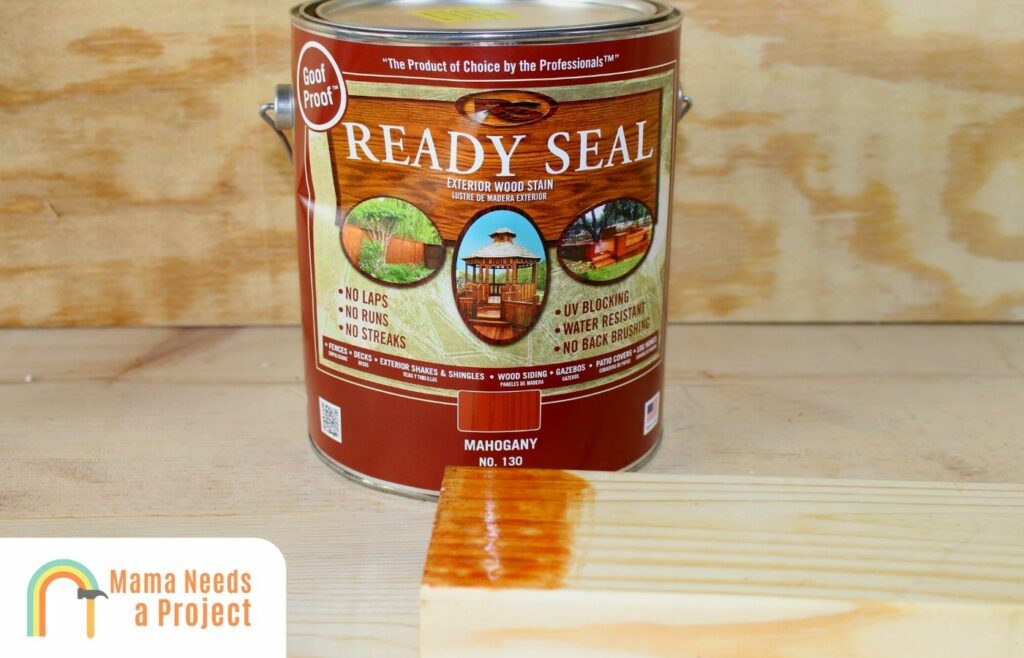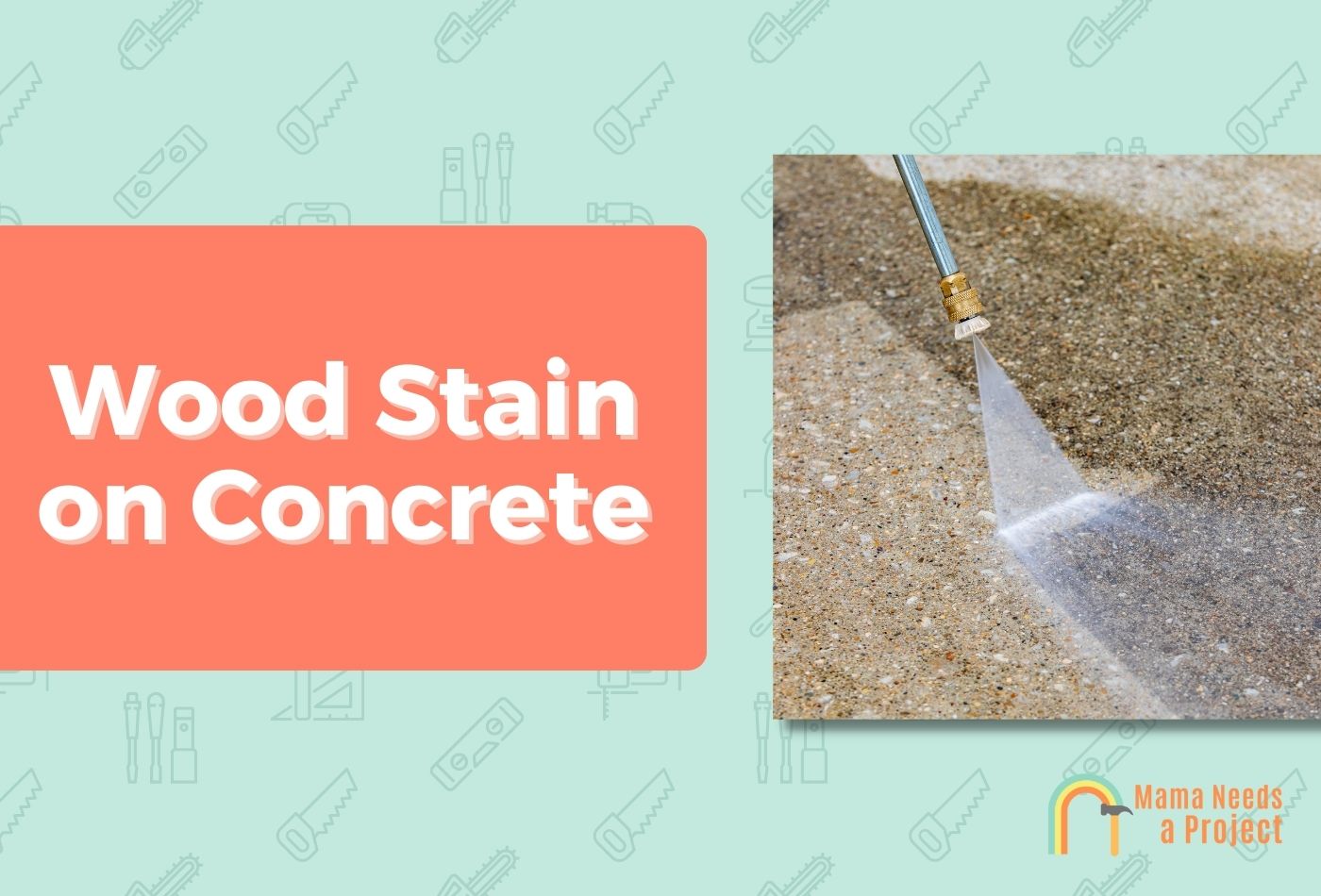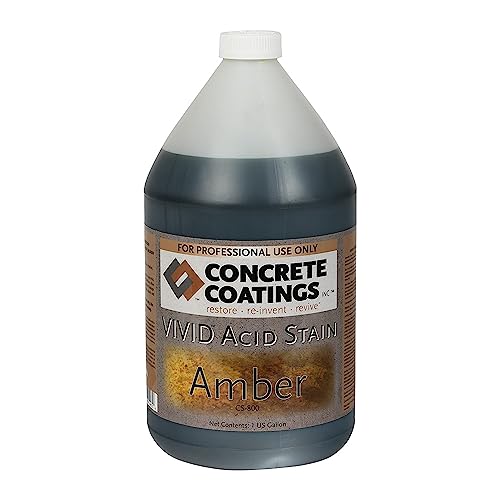Wood Stain on Concrete (Ultimate 2024 Guide)
There’s no doubt that wood stain can make the look of any surface that much better.
But can you use wood stain on concrete?
In this guide, I’ll explain if you can use wood stain on concrete, some tips to stain concrete, and much more. Let’s dig in!
- Yes, wood stain can be used on concrete, but it won’t be nearly as effective as stains that are designed for concrete. Wood stain dries on concrete’s outermost layer, and once completely dry it’ll start to peel.
- Concrete stains, on the other hand, seep into the material before drying, leaving a visually appealing and durable finish.
Can You Use Wood Stain on Concrete?

Wood stain can be used on concrete, but applying wood stain to concrete may not yield the results you expect.
You see, concrete doesn’t receive wood stain like wood does. In other words, wood stain won’t seep into concrete because there are no wood pores to seep into.
Instead, wood stain will dry on the surface of the concrete, much like how paint would. But whereas paint is designed for this kind of application, wood stain is not, so once it’s dry it’ll start to peel and flake off.
That said, if you can get a sealer coat down quick enough, you may be able to prevent the stain from peeling, discoloring, etc.
There are, however, stains designed for concrete surfaces, and these work on concrete like wood stains work on wood; I’ll cover this topic in depth later on.
But right now it’s best to cover how wood stain can be applied successfully to a concrete floor.
How to Use Wood Stain on Concrete
1. Prep the Surface
Like other surfaces, concrete surfaces have to be adequately prepped before a finish is applied.
First, you should patch any large gaps, cracks, and crevices. Doing this ensures no spot gets over-saturated once you start applying stain.
In the case of stain, if the surface isn’t roughed up beforehand, the stain will have a hard time penetrating the material. And if the stain can’t penetrate, it won’t set properly.
Go over the surface with a concrete grinder to rough it up. Once you’re done, vacuum up the dust you created; then use a tack cloth to remove any caked-on dust.
2. Prep Your Stain
If you’re using water-based stain, you don’t need to do any thinning beforehand. But if oil-based stain is what you’re using, you should thin it with mineral spirits (paint thinner) before applying.
Slowly stir the stain for a minute or so before loading it into your spray gun (if you’re using this applicator).
3. Apply Stain
How you should apply the stain largely depends on the applicator you chose.
So, if you chose a sprayer—which I recommend—you should start spraying in an up-down or side-to-side fashion.
The most important thing while spraying is that you follow the same movement pattern until the entire surface has been coated.
And if you’ve chosen a roller, start at one of the far ends of the surface.
If it’s a horizontal concrete surface, I recommend rolling in an up-down motion against the long sides of the surface. This way you don’t have to cover a large space with one roll.
5. Seal the Surface (Optional)
Once you’re done staining concrete, you should seal it with either water-based or oil-based polyurethane.
Polyurethane is by far the strongest sealant for concrete, and it’ll adhere well and last a long time if it’s applied correctly.
What’s the Best Applicator for Concrete Stain?
As far as applying stain to concrete is concerned, there’s no superior applicator. That said, I prefer using both rollers and sprayers.
Brushes, on the other hand, don’t do as well because concrete is rarely a uniformly flat surface, and this is the kind of surface that brushes get the best results on.
I prefer spraying stain because you don’t have to worry about roller marks, and also because this applicator can get top-notch results in a short period, especially if you know what you’re doing.
The only downside is you’ll have to spray downward, which can be difficult and messy. But if you ensure the paint stream isn’t highly pressurized, there will be much less splattering.
When you stain concrete floors with a roller, you need to make sure you don’t over-apply, as removing excess stain from concrete is rarely easy.
And you need to always roll in one direction—vertically or horizontally—until the job is complete. If you don’t, the paint roller will leave criss-cross patterns that’ll be present even after the stain has dried.
Note: But if your intention IS to create such a pattern, any foam or wool paint roller will do.
Are you looking for tips on how to apply concrete stain? Check out the video below!
Benefits of Staining Concrete
Visual Appeal
Regular concrete isn’t visually appealing like natural wood. However, it can be beautified with special stain.
If you want to make a concrete floor one solid color throughout, you should use a water-based stain.
Water-based stains soak quickly into concrete, and once set the curing process can begin.
There are no oil-based stains for concrete because these stains would be too viscous; they’d dry atop the surface like regular wood stain. But they wouldn’t dry all the way through, so they’d have to be scraped off.
But if you want your concrete floor to be a unique, visual masterpiece, this is where acid-based concrete stain comes in.
The chain reaction this stain causes when it hits concrete will lead to some spectacular colors and designs being formed.
Durability
Concrete is a pretty durable material on its own, but even it can be strengthened by a coat of new stain.
Specifically, the stain will make the surface more resistant to scratches and impact damage.
But if ensuring top-notch durability is a priority of yours—as it should be—then you should use a reliable sealer after staining concrete.
I recommend water-based polyurethane because it dries clear and works well on concrete surfaces. It’ll protect the stained concrete from moisture, mold and mildew, UV rays, temperature fluctuations, and other elements that can damage it.
Easy Maintenance
Stained concrete is also easy to maintain, so long as you clean it regularly with the right cleaning products. Annual maintenance is fine, but bi-annual maintenance may be necessary if the concrete floor sees a lot of foot traffic day in and day out.
To maintain concrete stain, all you have to do is touch up the spots that look faded; you should also remove any peeling stain and re-stain accordingly.
But if annual maintenance is too much for you, then you should coat concrete with a sealant after using stain.
Sealers require maintenance every 2-3 years, and all you have to do is add another thin coating to the existing concrete sealer.
Wood Stain vs Concrete Stain
Wood stain and concrete stain are more similar than they are different, but it’s the ways in which they’re different that make one good for a certain surface and the other ideal for a different kind of surface.
There are two kinds of concrete stain: water-based and acidic.
Water-based stain works a lot like wood stain. You apply it to the concrete, it seeps in, eventually it cures, and you’re left with a visually appealing and stronger concrete surface.
Acid-based stain, on the other hand, causes a chemical reaction when it meets the material, and this reaction causes the concrete to display incredibly unique colors and patterns.
- Wide range of colors and shades to choose from
- Will not chip, crack or peel
- Variegated color
Once you’re satisfied with what you see, all you have to do is apply a neutralizing agent and the reaction will cease.
Give the concrete a few days of drying time and it’ll be ready for normal use; 4-5 days of drying time is recommended for interior concrete floors that see a lot of foot traffic.
Can You Stain Sealed Concrete?
Yes, you can stain concrete that’s already been sealed, but here too the stain would dry at the surface level before peeling or flaking off soon after.
You could, however, put a thin layer of acrylic polymer-modified concrete on top of the sealed concrete and stain this.
So long as you use water-based or mild, acid-based stain that’s specifically for concrete, you shouldn’t have a problem.
But if you choose an acid-based stain, use a minimal amount, as too much could break down the new layer of concrete and negatively impact the sealed surface underneath.
How to Clean Stained Concrete
1. Dry Clean
Fortunately, you don’t have to thoroughly scrub a concrete floor weekly to keep it in good condition.
Instead, you should vacuum the floor at least twice a week with a dry vac, preferably one that has a horsehair brush. The vacuum will quickly suck all loose dirt and dust off the floor.
Just make sure the vacuum you’re using doesn’t have a beater bar/brush, as this can scratch the surface.
And if you don’t have access to the right vacuum, you could use a wet mop, but this won’t get rid of all the dirt and dust as easily.
2. Mop With Concrete Cleaner
Without a doubt, the most important part of the cleaning process is choosing the right cleaner.
You should use a cleaner that has a pH between 6.5 and 7.0, and remember that the wrong cleaner could fade or even strip the stain.
Specifically, harsher cleaners like Pine-Sol, bleach, and vinegar shouldn’t be used anywhere near concrete—especially if it’s sealed—because these cleaning agents can break down even durable sealants and erode concrete.
Finally, all you need is one ounce of cleaner per gallon of freshwater.
Need to attach wood to concrete? Check out these ways to attach wood to concrete without drilling!
FAQs
What kind of stain can you use on concrete?
The two main concrete stains are water-based and acidic. Use water-based when you want a smooth finish that’s all one color. Acidic is better when you want a unique assortment of colors and patterns. Of the two, water-based is easier to use, as you don’t have to carefully watch it after the application.
Can you put wood stain on concrete?
Wood stains can be applied to concrete floors, but they won’t last unless they’re sealed once completely dry. Wood stains can’t penetrate concrete like stains that are designed for this, and even if they could they’d have no pores to set in. And while it may work as an above-surface finish, paint is much better.
How long does concrete stain last?
If it’s applied right and sealed immediately, concrete stain should last 3-5 years—the same lifespan most wood stains have. Once your stained concrete floor looks noticeably faded, you should re-stain and reseal it. And when you re-stain, you don’t have to use the same kind of stain, but consistency is recommended.
Final Thoughts
To recap, while you can use wood stain on concrete floors, it’s best to use concrete stain instead.
Water-based concrete stain is quick-drying, easy to use, and less toxic, so it’s ideal for those who want one solid color from end to end.
But if you want to get more creative, opt for acid-based concrete stain, as this can create wonderfully unique colors and patterns.
Lastly, both stains strengthen concrete too. Still, a sealer should be used regardless of the stain you choose.


